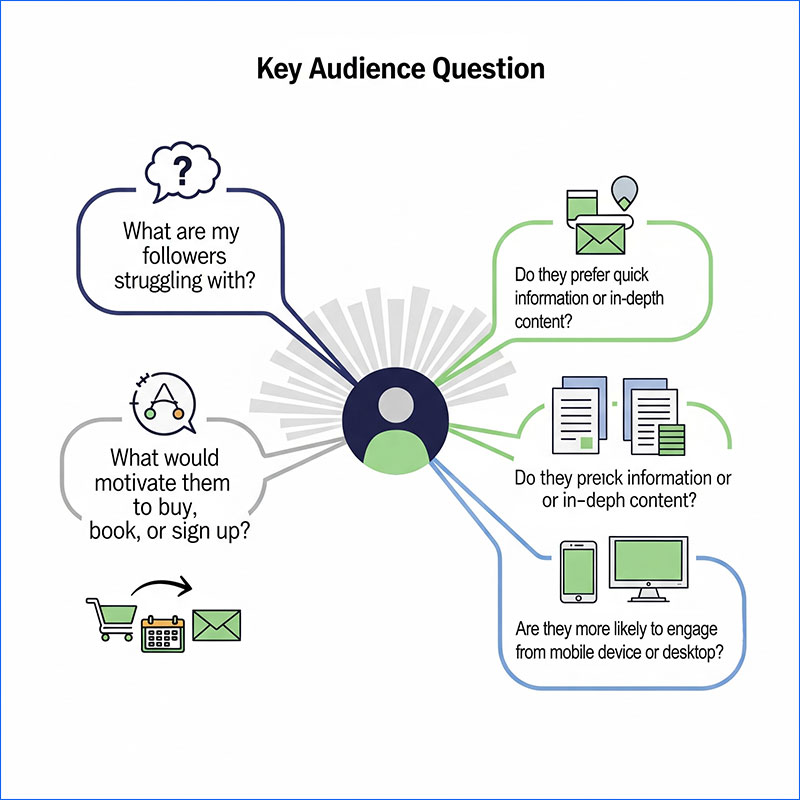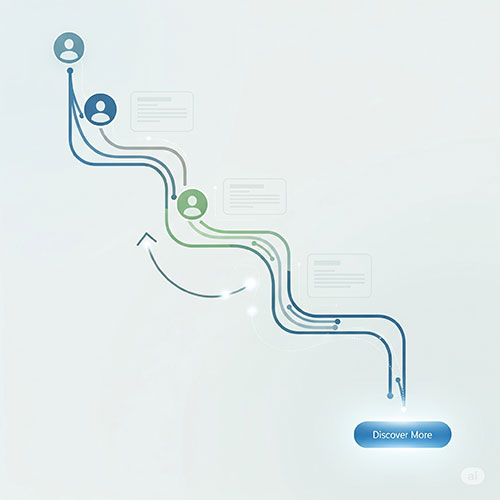Learning how to design a website that converts is one of the smartest moves any business can make. Social media platforms like Facebook, Instagram, and LinkedIn are excellent for building awareness, but they limit your control over the audience experience. A well-crafted business website bridges that gap, giving you full ownership of your content, branding, and user journey. By creating a site that turns casual visitors into paying customers, you establish a reliable hub that drives real results for your business.
It takes the attention you’ve built on social media and channels it into action—whether that’s making a purchase, booking a consultation, or signing up for updates. This guide will walk you through how to build a site that’s not just good-looking, but also how to design a website that converts.
Start with Your Customers in Mind
Before you focus on colors or layouts, think about the people visiting your site. What are they hoping to find? What problem are they trying to solve? Understanding your customers’ mindset helps you create a site that feels relevant and useful. Here are some helpful questions to consider:

Your answers will shape the way your website communicates and how it guides visitors toward action.
Working with an Agency to Design a Website
There are plenty of tools like Wix and WordPress that let you build a site on your own—but doing it right takes more than just a template. A web agency helps turn ideas into results, and how to design a website that converts. They understand how to guide a visitor through a website with ease, helping turn curiosity into conversions. From designing custom layouts to making sure your site runs smoothly on every device, agencies build with both form and function in mind.
Benefits of working with a trusted agency:
Custom website design tailored to your brand and goals: An agency works closely with you to ensure the look, feel, and functionality of your site reflect your business identity. This includes custom layouts, colors, and messaging that speak directly to your audience.
Call to action
Clear calls-to-action that drive results: Agencies know how to guide visitors through your site with strategically placed buttons, links, and prompts that encourage action—whether that’s making a purchase, requesting a quote, or signing up for a newsletter.

SEO best practices baked into every page: From keyword usage and meta descriptions to internal linking and page speed, agencies build your site with the right search engine optimization techniques so you show up where your customers are searching. It’s all part of the plan on how to design a website that converts.
Fast, responsive, mobile-friendly website design: More than half of your traffic is likely coming from mobile devices. Agencies make sure your site looks and works great on every screen, improving both user experience and conversion rates.
Ongoing technical support and updates: When issues arise—or when it’s time for a refresh—agencies offer continued support. This includes fixing bugs, updating plugins, improving site speed, and helping you adapt as your business evolves.
Integration with tools like email marketing, booking forms, and analytics: A great website does more than just look good—it connects to the systems that keep your business running. Agencies can seamlessly integrate platforms like Mailchimp, Calendly, and Google Analytics to streamline their marketing and track their performance.
Partnering with an experienced agency means you’re not just building a website—you’re building a complete sales engine that supports your goals from day one.

Are you interested in maximizing your online growth? We can help with Web Design, SEO, Brand, AI, and Content Writing. Talk to Us! Call: (857)400-8959
What Makes a Website Convert?
There’s a big difference between a website that looks nice and one that gets results. A high-converting site removes distractions and makes the next step obvious. That could mean scheduling a consultation, filling out a form, or downloading a resource. Here are some essential features:
1. A Clean, Focused Homepage
Your homepage is often the first impression you make on a visitor—so it needs to be purposeful. Rather than trying to serve every possible need at once, focus on guiding users toward one main action. This could be scheduling a consultation, purchasing a product, or downloading a free resource.
A clean, uncluttered design with a clear message helps users understand exactly what you want them to do next. When people land on your site from social media, they should instantly feel like they’re in the right place. This is one of the methods how to design a website that converts.
2. Trust Signals That Reassure
Trust is one of the biggest barriers between a visitor and a purchase. Including real testimonials, client reviews, press mentions, case studies, or recognizable partner logos can immediately reassure someone who’s never interacted with your brand before.
These elements act as social proof—evidence that others have had a good experience with your business. Displaying them in a visible spot, like your homepage or just before a call-to-action, helps build confidence right when it matters most.
3. Simple Navigation and Fast Load Times
Even the best content or offer will fall flat if users can’t find it or the page doesn’t load. Keep your site structure simple with clear, intuitive menus. Make sure visitors can get to your most important pages—like Services, Contact, or Pricing—within one or two clicks.
Just as important is site speed. A few seconds of delay can increase bounce rates dramatically. Optimizing images, using reliable hosting, and minimizing scripts can keep your site fast and responsive.
2. Headlines That Match Intent
Your headlines are often what make users decide to stay or leave. When someone arrives from a social post or ad, they’re expecting a certain message or promise. Your headline should confirm that they’re in the right place—and lead them toward the solution they came for. Avoid vague language. Be specific, benefit-focused, and aligned with what originally got them interested.
3. Clear Buttons and Contact Options
If someone is ready to take the next step, don’t make them search for it. Buttons should stand out visually and be labeled with clear, action-oriented text like “Book a Free Call,” “Get a Quote,” or “Start Now.” Also, offer more than one way to get in touch—some people prefer forms, others want to call or email directly. Place contact info or action prompts in multiple places, like the top navigation, homepage, and footer.
Every part of your site should be intentional—working together to guide users, build trust, and make it easy for them to say yes.
Designing a Website with User Experience in Mind
A good user experience (UX) keeps people on your site longer—and increases the chance they’ll take action. This goes far beyond choosing nice colors or catchy headlines.
UX involves how easily someone can navigate your site, find the information they need, and complete the action you want them to take.
When a site feels smooth and intuitive, visitors are more likely to stay engaged, click through, and ultimately convert.

This means using readable fonts that don’t strain the eyes, maintaining consistent branding so users know they’re in the right place, and organizing layouts in a way that feels natural—especially on mobile. Since many visitors come directly from social media apps, mobile optimization isn’t optional; it’s critical. Your site should load quickly, be easy to scroll, and keep call-to-action buttons in thumb-friendly locations.
This is where working with a professional agency can make a real difference. Agencies understand how to map out user journeys, simplify layouts, test different experiences, and apply design choices that align with user behavior. They can also implement A/B testing and use real data to improve design decisions over time, which is crucial for a website that converts. Good UX isn’t just about aesthetics—it’s about removing friction and creating a site that feels effortless to use. That level of polish and performance is often hard to achieve without expert help.
Helping People Find Your Website (SEO Basics)
To help new users find your website through search engines like Google, use simple techniques called SEO (Search Engine Optimization). Start by identifying the key phrases your audience might type into a search bar—such as “best fitness community online” or “how to join a members-only cooking group”—and use those naturally in your headlines, content, and descriptions.
Adding fresh content regularly, such as blog posts, member stories, or event updates, helps improve your ranking and keeps users engaged.
While you can learn and apply some SEO tactics yourself, working with a professional agency can give your website a major advantage. Agencies understand how to structure content, optimize technical details, and implement the right tools to help your site show up in more searches. They also stay current with ever-changing algorithms, saving you time and helping your site perform better from day one.
Getting Your Website Off to a Good Start
When your website is ready, it’s important to launch it in stages. Start by inviting a small group of trusted customers, colleagues, or community members to try out the platform. Ask for honest feedback about their experience—what they like, what’s confusing, or what could be better.
This soft launch gives you the chance to fix bugs, adjust features, and fine-tune the website design before making it public. Once you’ve made those improvements, plan a wider launch. Promote your website through email campaigns, your current social media platforms, relevant guest blog posts, and targeted online ads. You might also consider offering limited-time incentives or early access perks to encourage sign-ups and build momentum.
Driving Traffic from Social Media

Once your designed website is live, promoting it through your social media channels becomes essential. Your followers already know your brand, so inviting them to your website should feel like a natural next step.
Add your website link to all relevant bio sections and regularly include it in posts, Instagram Stories, Facebook updates, LinkedIn content, and TikTok captions. Make sure your link goes directly to a landing page that matches what you promoted—whether that’s a free offer, a blog post, or a product.
Offering limited-time deals, free resources, or early access to something exclusive can give your followers a reason to click now instead of later. Consider running giveaways or discounts for website visitors who come from social media, and track which content performs best across platforms.
Use analytics tools like Brandwatch to gain visibility into how users are behaving once they land on your site. Are they clicking around and taking action, or bouncing off the page quickly? Are visitors from Instagram acting differently than those from Facebook or LinkedIn? These insights help you refine your content, targeting, and user experience to get better results over time.
Working with a professional agency can also amplify this process. They’ll know how to set up landing pages that match your campaigns, connect your social media channels to analytics software, and use retargeting strategies to bring visitors back if they don’t convert right away.
Turn Your Website into a Business Tool
Social media might be where your audience finds you, but your website is where you convert them.
A well-built site becomes more than just an online brochure—it’s a lead generator, sales funnel, customer support platform, and brand-building tool all in one.
Depending on your business, this could mean integrating e-commerce capabilities, setting up appointment scheduling, or building out downloadable resources and email list incentives. Every feature should be aimed at helping your visitors take the next step.
An experienced agency can help ensure your website works as hard as you do. From lead capture forms and CRM integration to automated email workflows and checkout systems, agencies design sites that serve your goals around the clock. Instead of treating your website as something you launch and forget, an agency helps you turn it into a living tool that evolves with your business and maximizes the return on your social media efforts.
Conclusion
A website that converts doesn’t happen by accident—it’s the result of intentional design and strategy. By focusing on clarity, trust, speed, and user intent, you guide visitors seamlessly toward taking the next step. Whether it’s booking a consultation, making a purchase, or downloading a resource, every element of your site should work together to remove friction and build confidence. When your website feels intuitive and trustworthy, conversions follow naturally. That’s how to design a website that converts.

Author Bio:
Megan Isola holds a Bachelor of Science in Hospitality and a minor in Business Marketing from Cal State University, Chico. She enjoys going to concerts, trying new restaurants, and hanging out with friends.
Schedule a Discovery Session
"*" indicates required fields
We hope that you enjoy our content. If you decide to make a purchase after clicking on one of our affiliate links, we’ll earn a small commission at no extra cost to you. Thanks for reading! View our Affiliate Disclosure


Excellent article with very practical points. Converting social media followers into real customers depends a lot on how well the website is designed from clear CTAs to smooth navigation and fast loading pages.